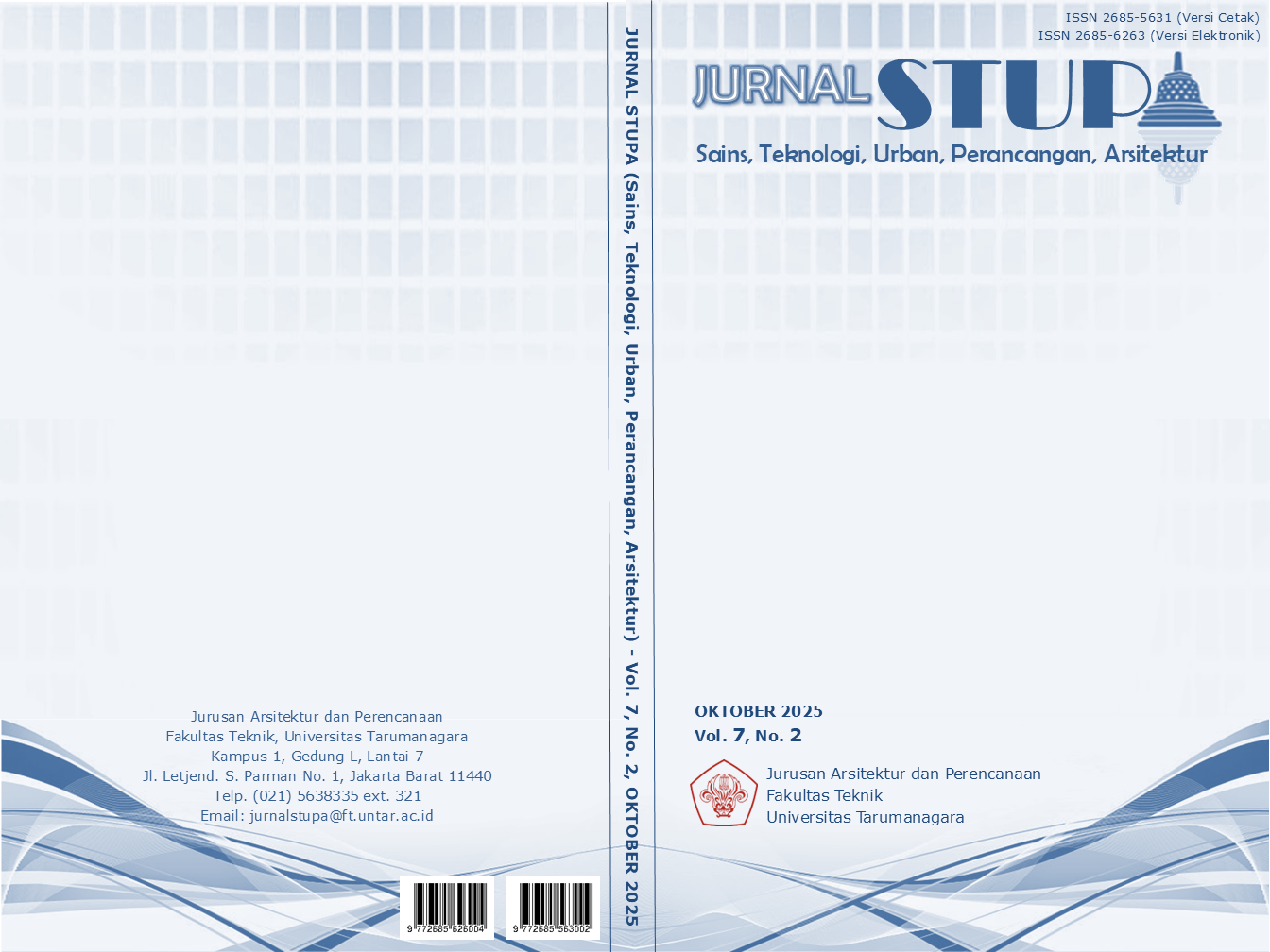RUANG SEHAT DI TENGAH POLUSI: PENERAPAN PURIFIKASI UDARA BERBASIS AIR PADA COMMUNITY HUB DI CAKUNG
Main Article Content
Abstract
Air pollution is one of the most critical environmental challenges faced by the city of Jakarta, with significant impacts on public health, the economy, and overall quality of life. The largest emissions originate from the transportation sector, followed by industrial activities, construction, and open burning. Vulnerable groups such as children, the elderly, and individuals with respiratory illnesses—especially those living near major roads and industrial zones—are the most affected. This research aims to formulate regenerative architectural design strategies with the goal of creating healthy living environments in response to air pollution. The main focus is directed toward the use of water-based air purification systems as an active solution integrated into building and public space design. The methods used include literature studies, field observations, mapping of high-pollution areas, and design analysis based on air filtration technologies and green open spaces. Expected outcomes include the identification of spatial characteristics of affected areas, the development of architectural design prototypes that function as an air purification media, and contextual design guidelines for dense urban areas in Jakarta. These findings are expected to contribute concretely to addressing the air pollution crisis through the strategic role of architecture in improving the quality of the urban environment.
Keywords: air pollution; air purification; health; regenerative
Abstrak
Polusi udara merupakan salah satu tantangan lingkungan paling kritis yang dihadapi kota Jakarta, dengan dampak signifikan terhadap kesehatan masyarakat, ekonomi, dan kualitas hidup. Emisi terbesar berasal dari sektor transportasi, diikuti oleh aktivitas industri, konstruksi, dan pembakaran terbuka. Kelompok rentan seperti anak-anak, lansia, serta penderita penyakit pernapasan, terutama yang tinggal di dekat jalan utama dan kawasan industri, menjadi yang paling terdampak. Penelitian ini bertujuan untuk merumuskan strategi desain arsitektur regeneratif dengan target menciptakan ruang hidup yang sehat terhadap polusi udara. Fokus utama diarahkan pada pemanfaatan sistem purifikasi udara berbasis air sebagai solusi aktif yang terintegrasi dalam desain bangunan dan ruang publik. Metode yang digunakan mencakup studi literatur, observasi lapangan, pemetaan kawasan dengan tingkat polusi tinggi, serta analisis desain berbasis teknologi penyaring udara dan ruang terbuka hijau. Hasil yang diharapkan meliputi identifikasi karakter spasial wilayah terdampak, pengembangan prototipe desain arsitektur yang berfungsi sebagai media purifikasi udara, serta panduan desain kontekstual untuk wilayah urban padat di Jakarta. Temuan ini diharapkan dapat menjadi kontribusi nyata dalam merespons krisis polusi udara melalui peran strategis arsitektur dalam peningkatan kualitas lingkungan perkotaan.
Article Details

This work is licensed under a Creative Commons Attribution-NonCommercial-ShareAlike 4.0 International License.
This work is licensed under a Jurnal Sains, Teknologi, Urban, Perancangan, Arsitektur/ STUPA Creative Commons Attribution-NonCommercial-ShareAlike 4.0 International LicenseReferences
A Ameta, R., Solanki, M. S., Benjamin, S., & Ameta, S. C. (2018). Photocatalysis. In S. C. Ameta & R. Ameta (Eds.), Advanced oxidation processes for wastewater treatment. Academic Press.
Audrey. (2021). Benefits of a water air purifier. Airpurifiers.sg. Retrieved April 17, 2025, dari https://airpurifiers.sg/benefits-water-air-purifier/
Al-Ajlalin, F. A. H., Idris, M., Abdullah, S. R. S., Kurniawan, S. B., & Imron, M. F. (2020). Design of a reed bed system for treatment of domestic wastewater using native plants. Journal of Ecological Engineering.
Armstrong, R. (2023). Introducing regenerative architecture. Journal of Chinese Architecture and Urbanism.
Badan Pusat Statistik (BPS) Jakarta. (n.d.). Jumlah kasus penyakit menurut provinsi/kabupaten/kota dan jenis penyakit. Retrieved April 17, 2025, from https://jakarta.bps.go.id/id/statistics-table/2/NTA0IzI=/jumlah-kasus-penyakit-menurut-provinsi-kabupaten-kota-dan-jenis-penyakit--.html
BBC News. (2023). Jakarta’s air pollution crisis: Indonesia’s capital among the most polluted cities in the world. Diakses Juli 6, 2025, dari https://www.bbc.com/news/world-asia-66496992
Bishop, S. (2022). Why both the climate change and air pollution crises are environmental justice issues. Clarity. Diakses Mei 8, 2025, dari https://www.clarity.io/blog/why-both-the-climate-change-and-air-pollution-crises-are-environmental-justice-issues
Bourdrel, T., Bind, M.-A., Béjot, Y., Morel, O., & Argacha, J.-F. (2017). Cardiovascular effects of air pollution. European Heart Journal.
Clean Air Fund. (2025). Indonesia. Clean Air Fund. Diakses April 17, 2025, dari https://www.cleanairfund.org/geography/indonesia/
Climate and Clean Air Coalition. (2020). Identifying the main sources of air pollution in Jakarta: A source apportionment study – Technical brief. Diakses April 17, 2025, dari https://www.ccacoalition.org/resources/identifying-main-sources-air-pollution-jakarta-source-apportionment-study-technical-brief
Fahmy, A., Abdou, A., & Ghoneem, M. (2019). Regenerative Architecture as a Paradigm for Enhancing the Urban Environment. Port‑Said Engineering Research Journal.
Firdaus, F. M., Elliott, B., Malsch, J., & Surjadi, P. (2023). 7 things to know about Jakarta’s air pollution crisis. World Resources Institute. Diakses Juli 4, 2025, dari https://wri-indonesia.org/en/insights/7-things-know-about-jakartas-air-pollution-crisis
Fry, S. (2022). Air-cleaning architecture: Building a greener future. Luxiders. Retrieved May 8, 2025, From https://luxiders.com/air-cleaning-architecture-building-a-greener-future/
Fujishima, A., & Honda, K. (1972). Electrochemical photolysis of water at a semiconductor electrode.
IQAir. (2021). 2021 World Air Quality Report: Region & City PM2.5 Ranking. IQAir.
IQAir. (n.d.). Jakarta air quality index (AQI) and air pollution. Diakses April 17, 2025, dari https://www.iqair.com/id/indonesia/jakarta
Kafle, A., Timilsina, A., Gautam, A., Adhikari, K., Bhattarai, A., & Aryal, N. (2022). Phytoremediation: Mechanisms, plant selection and enhancement by natural and synthetic agents. Environmental Advances.
Lee, S. U., Lee, J. Y., Lee, S. H., & Jeon, G. W. (2023). A sustainable water vortex-based air purification for indoor air quality. Building and Environment.
Lewinski, M. L., & Ariaji, P. E. (2024). Penerapan pendekatan eksperimental rasionalisme yang empatik dalam desain fasilitas pengolahan udara bersih di Jakarta. Jurnal STUPA.
Manisalidis, I., Stavropoulou, E., Stavropoulos, A., & Bezirtzoglou, E. (2020). Environmental and health impacts of air pollution: A review. Frontiers in Public Health.
National Center for Biotechnology Information (NCBI). (2023). Estimating the health impacts of air pollution in children. Int J Environ Res Public Health.
Park, J. K., & Oh, K. (2023). Advancements in Phytoremediation Research for Soil and Water Resources: Harnessing Plant Power for Environmental Cleanup. Sustainability.
Staszowska, A. (2020). Air purification in sustainable buildings. Problemy Ekorozwoju – Problems of Sustainable Development.
Pramitha E, Haryanto B. (2019). Effect of Exposure to 2.5 μm Indoor Particulate Matter on Adult Lung Function in Jakarta. Osong Public Health Res Perspect.
Prana Air. (n.d.). Fresh air machine. Diakses April 17, 2025, dari https://www.pranaair.com/us/fresh-air-machine/
Xue, H., Lv, Q., Liu, Y., Fu, K., Wei, Y., Zhang, Y., & Wang, B. (2025). Investigation of water-soluble ions removal through enhanced heat exchange based on cloud-air-purifying technology. Powder Technology.



